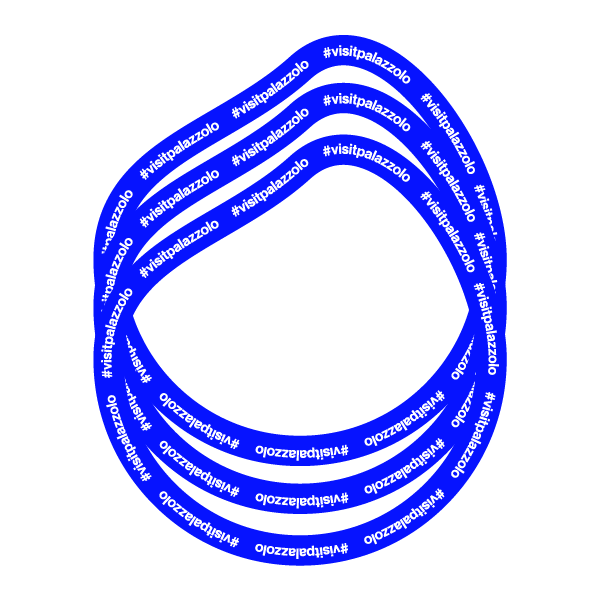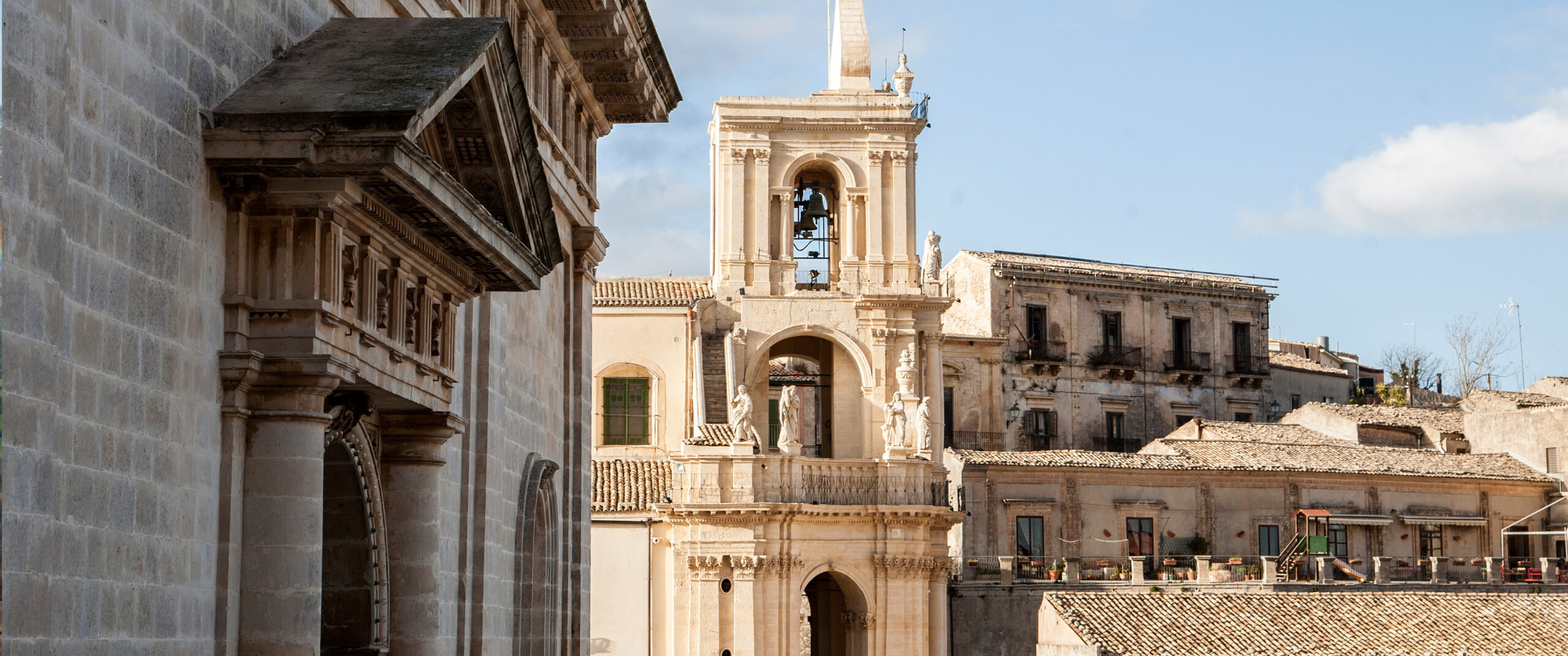The Baroque
Churches of Palazzolo Acreide: Art and Faith
Palazzolo Acreide’s Old Town is a veritable gallery of Sicilian Baroque religious architecture, each church a unique expression of faith and artistic brilliance. Rebuilt with fervor after the 1693 earthquake, these sacred spaces showcase the ornate and theatrical style that defines the region.
The Chiesa Madre di San Nicolò Vescovo stands proudly with its grand staircase and a facade rich in sculptural detail, a testament to the town’s resilience and devotion. Not far away, the Chiesa dell’Annunziata captivates with its elegant curves and harmonious proportions, a more restrained yet equally impressive example of Baroque design.
Dominating its piazza, the Chiesa di San Sebastiano is a true showstopper, its facade adorned with a vibrant array of sculptures depicting the martyrdom of the patron saint, all leading up to its majestic bell tower. Each of these churches, along with others scattered throughout the town, tells a story through their intricate carvings, soaring interiors, and the warm, golden hues of the local stone.
Visiting the Baroque churches of Palazzolo Acreide is an essential part of experiencing the town’s soul, offering a glimpse into its history, art, and enduring spirit. They are not just places of worship, but architectural gems that continue to inspire awe and wonder.
Basilica di San Paolo

The Basilica was built around the mid 18th century in an urban area where there
once had been a small church that was consecrated to Saint Sophia. The Basilica
was destroyed by the 1693 earthquake and was then rebuilt between 1720 and
1730.
The splendid facade which was probably created by Vincenzo Sinatra, an artist
from Noto, is one of the most beautiful exemplars of the local Baroque style. Built
in the late 1700’s, after the pronaos facade was built, it presents various distincti-
ve features such as the impressive stairway, which has two flights of a different
width that end in the huge bronze portal which depicts the life of the patron saint
as well as rich sculotural decorations.
The three orders of the facade are decorated with alternate arches and columns
topped with Corinthian capitals. In the first order there are five arches – the late.
ral arches are separated from the central ones by two pairs of Corinthian columns
resting on the large plinth that is present in the whole base of the building.
The second order has a central compartment where nearly miraculously appears
a huge Christ that is giving his blessing with two guardian angels on each side,
whereas the third order rises up into a tower that contains the bell. Six pairs of the
statues of the Apostles are spread throughout the entire facade and up until the
early 1900’s there was a frieze, which has now been restored, that portrayed a
sword, the symbol of the Apostle Paul, coiled by a snake and inserted in a royal
crown.
The interior of the basilica is divided into three naves that are enhanced by
the rich vault, the twisted columns that dominate the apse, the numerous pre-
cious paintings and the huge organ which is placed above the entrance portal. The
church has eleven altars of which two can be found in the two side chapels. The
main altar, with its polychrome marble, is dated 1868 and there is a beautiful 16th
– 17th century crucifix. Between the two enormous polychrome columns of the
altar and behind the Crestadoro painting that portrays the conversion of St. Paul,
there is the niche that safeguards St. Paul’s statue. St. Paul was elected principal
patron saint of Palazzolo in September 1689. This statue, created by Vincenzo Lo-
refice from Ragusa in 1567, has undergone various interventions of conservation
and embellishment through the centuries that have altered the original image
When it was delivered, in the 16th century, the statue had been painted in tempe.
ra and with uniform colours, the robe was blue and the cloak was red. The major
works of art are the organ, which originally was placed between the first and the
second pillars in the left nave and in the 1930’s was moved to the choir, several
splendid paintings by Giuseppe Crestadoro that are above some of the altars. In
the sacristy there is the impressive high chair and the four presbytery chairs that
were carved by Giuliano in 1860, the precious cupboard that was created in 1778
by Giovanni Torrisi from Catania and Gaetano Rametta from Syracuse as well as
four huge cupboards, chests and four exquisite paintings.
Basilica di San Sebastiano
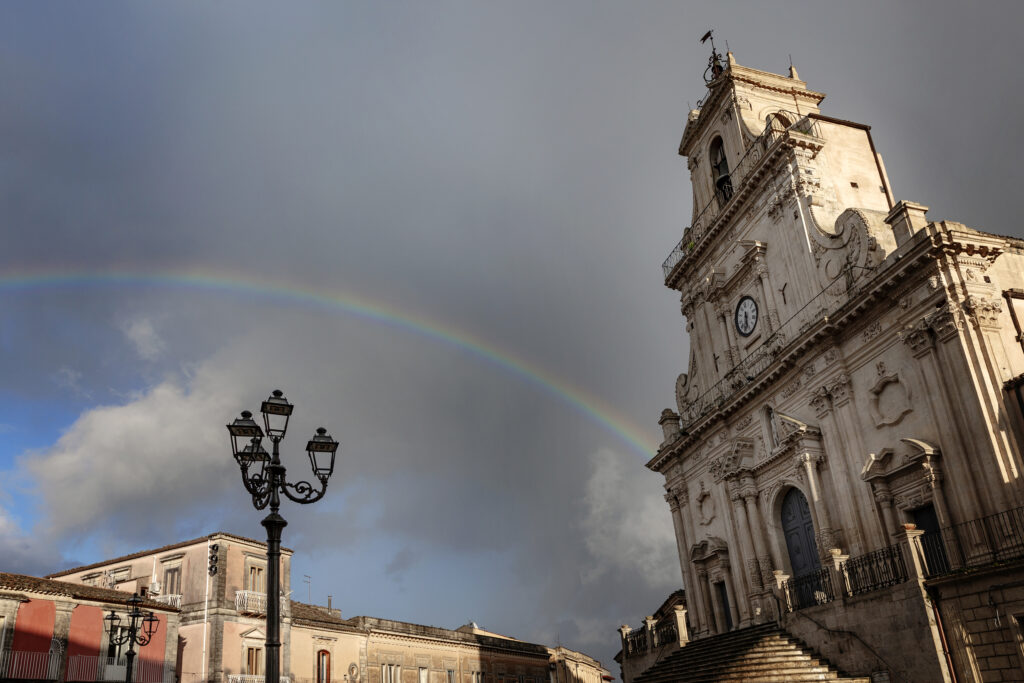
The original church was built in its present site next to a small church that was consecrated to Saint Rocco, probably in the second half of the 14th century. It underwent some extension work in the 16th century. The 1693 earthquake destroyed nearly all of the church and it was then rebuilt in the early 1700s.
The facade, which was designed by the master architect Mario Diamanti from Syracuse, was built in 1721 and is divided in three orders which are preceded by a scenic stairway. The first order is decorated by a lovely portal which is framed by four paired columns and at its base there are two Labisi lions, one on each side. The clock is in the second order and the bell lodge is in the third – the bells date back to the early 1800s. The facade, with its bell tower, was completed around 1768. The interior is divided in three naves which are dominated by the main altar with its splendid marble and beautiful stucco statues which were carved by Gioacchino Gianforma from Catania in 1784. There are three large
18th centurv frescoes on the vault of the central nave while all the other altars are decorated with valuable stucco and marble as well as beautiful paintings and statues of the saints. Brother Giacinto Farina assertained that some of the altars were built with marble that came from the “Purbella” city quarter of Palazzolo. One of the more prestigious altars is that of Saint Mauro which was painted by Giuseppe Tanasi in 1853. Some other noteworthy altars are the Saint Sebastian and Saint Rocco altars by unknown artists and the painting of Saint Peter in Vincoli which was painted by Marcello Vieri in 1785.
Another painting is that of Saint Luigi Gonzaga which was painted by Giovanni Tanasi in 1855 Gioacchino Gianforma decorated all the vaults and arches in the three naves,
the stucco statues and the marbling of the columns in the church. The nave is closed by an apse with the Holy Crucifix side chapel that was built in 1721 by the confraternity of the same name. In the sacristy, there is an enormous wardrobe with engravings and bas-reliefs which are of a very high artistic level. It is believed that it is a work of the Costa family – a renowned family of cabinet makers. The statue of St. Sebastian is placed in the niche above the main altar.
It was sculpted in Augusta in 1693 but the author of the statue is unknown. On the left nave there are various altars and the side chapel, with its fine architecture has an altar that holds St. Urbano’s body which was brought to the church in 1762. The alta dedicated to St. Margherita of Cortona has a splendid painting by Olivo Sozzi which was painted in 1758. The altar dedicated to St. Maria of Odigitria has an ancient statue of the Madonna which was brought to the church by the Calogeri. And finally the altar dedicated to the Souls of Purgatory has a painting by Piero da Quintavalle which was painted in 1855. Also no teworthy is the impressive organ which was created by Carlo del Piano between 1728 and 1729 and is considered one of the most precious in Sicily.
Chiesa di San Michele
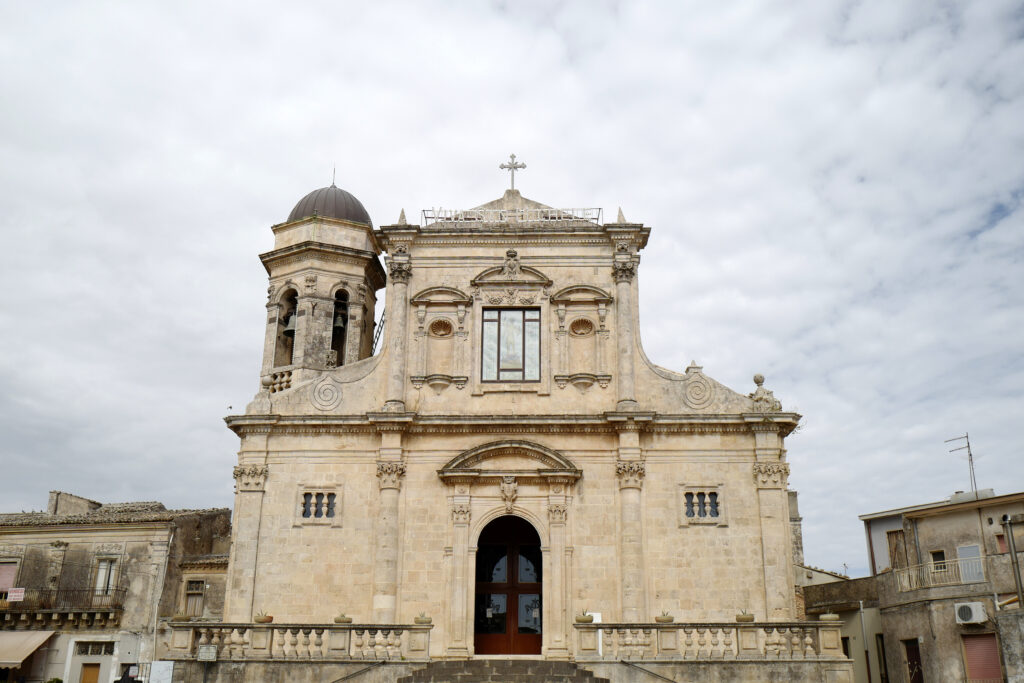
Having been built between the 15th and the 16th centuries, and then rebuilt after the 1693 earthquake, St. Michael’s Church was consecrated by Pope Benedict XIII in 1727.
Bereft of any architectural value in its exterior, the facade, which is elevated from the ground level by a stairway, is quite simple in its two orders; the central portal is between two columns in the Corinthian style and above it there is a wide window which has two clamshell niches on each side. The bell tower with a dome stands on the left side of the church. In the interior, the church has three naves and lateral archs all round, as well as columns in white stone with a smooth shaft and Corinthian capitals. Behind the main altar, which is rich in polychromatic marble, is a 16th century painting of Saint Michael and the wooden statue of the saint is kept in a niche behind the painting.
Along the right handed nave there are four small altars that are placed between semi-columns that lay on high plinths which are placed against the wall.
On the left handed nave, where there is also a secondary entrance, there are another two altars placed against the wall. There is a valuable walnut wardrobe, an ivory crucifix and a small coral masterpiece which represents St. Michael killing a dragon in the sacristy.
Chiesa dell' Annunziata
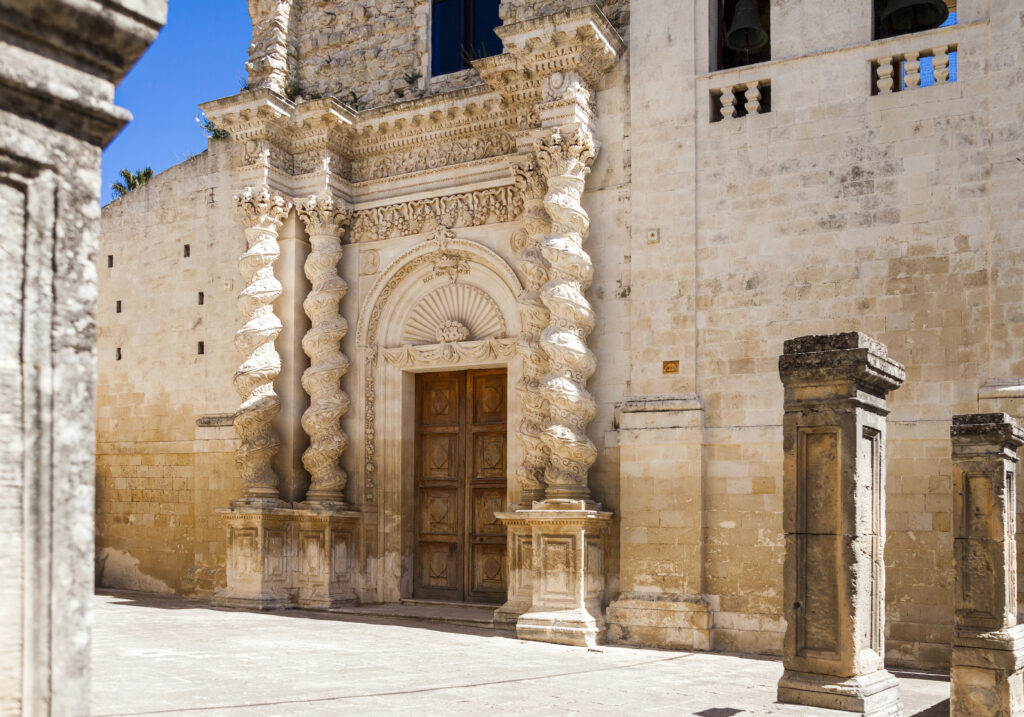
Considered the oldest church in Palazzolo, it was probably built between the 13th and the 14th centuries, and having been destroyed during the 1693 earthquake, it was rebuilt in the same site by the architect Matteo Tranisi. It is definitely the jewel of Palazzolo’s 17th century artwork. The exterior of the church is distinguishable from its wide portal
which features four bined twisted columns that are richly adorned with vines and friezes that represent agricultural motifs: quinces, pomegranates, grapes and other kinds of fruit, all in a natural size.
The facade is incomplete, and it is thought that it would have been completed with a bell tower and a pediment overlying the two pairs of columns.
The interior of the church has three naves, and the high arches above the central altar are also adorned with agriculural motifs. The main altar is very particular with its coloured polychrome marble which represents birds and delicate floral motifs that recall the allegory of Spring.
The altar holds a tabernacle which was sculpted in marble and which features a myriad of small columns that are surmounted by angel heads.
Behind the altar, there is a painting that represents the Annunciation of Our Lady. It was painted by Paolo Tanasi, a local artist The lateral naves are enhanced by various paintings.
In 1474, Antonello da Messina was commissioned by the chancellor of the church to create a large painting on wood of the Annunciation. The masterpiece remained in the church until 1906, when it was bought by a Syracusan government department for
its restoration and conservation. Today the painting is safeguarded in the Bellomo Museum in Syracuse.
Chiesa Madre
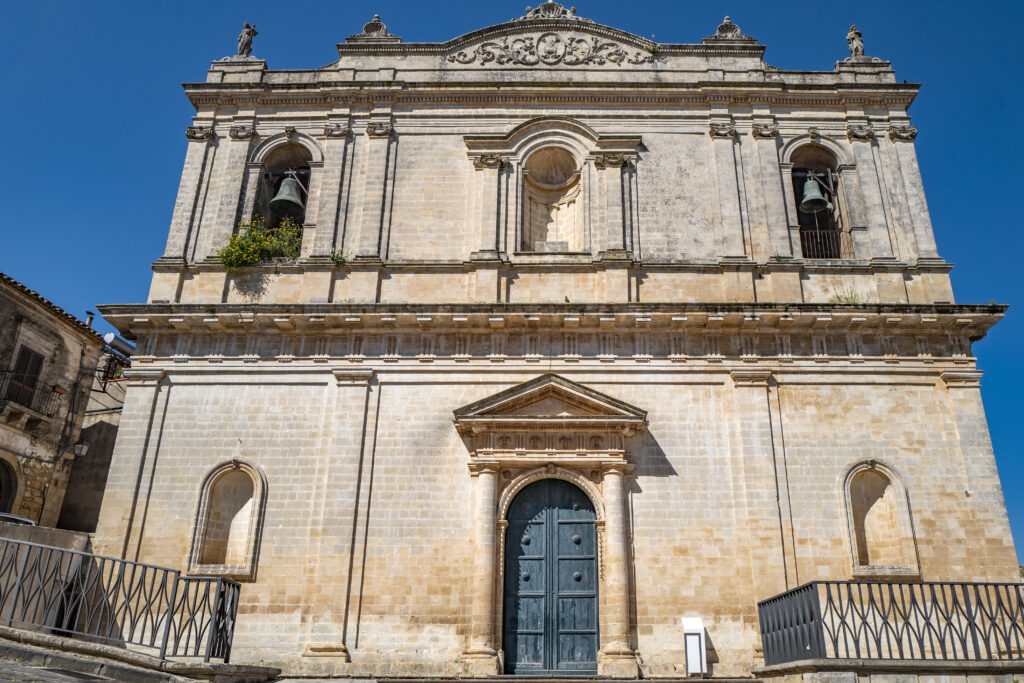
Archived documents attest to the existence of the church since 1215, the year in which the bishop of Syracuse, Bartolomeo Gash, dedicated it to the cult of Saint Nicolò. It is the biggest of all the existing churches in the town and was rebuilt after the 1693 earthquake. The facade can be attributed to a reconstruction that was carried out after a collapse that occurred in 1833. It is divided in two orders: in the lower order there is the central portal with a gable covering, and on each side there is a niche without a statue. The superior part of this order is completed by an architrave that is decorated with metopes
and triglyphs. The second order has the same architectural disposition as the lower order with the exception that in its centre there is a niche without any statues and on each side a window with bells. The higher part is completed by a frieze that is richly decorated and has a statue on each side. There are three naves in the interior – the central nave is separated from the lateral naves by four columns. The major apse has a 17th century wooden choir which frames the main marble altar, above which there was a painting of Saint Nicolò of Mira which was presumably painted by the Palazzolese painter Paolo Tanasi.
The four evangelists were illustrated under the vault of the apse. According to a local tradition, these images were known as the “varcacanni” because of their ugliness and represented the demons of the storms. In the ante-sacristy, there is an 18th century cupboard carved by the Costa family – an illustrious family of refined cabinet-makers. In the sacristy there is another cabinet, which dates back to 1760, and is decorated with statues that represent the saints; the cabinet safeguards a precious vicarial archive that contains documents that date back to 1400. The original sacristy can be accessed from a small door that is in the presbytery. It is the sole part of the building that remained standing after the 1693 earthquake.
The walls are of stone and in a niche there is a small handbasin which was used by the presbyters of that period. Furthermore there are some architectural elements that probably belong to the first foundation of the church. In the left nave there is a marble altar consecrated to St. Hippolytus with a painting by Pietro
Novelli which figures the saint’s matyrdom. In the right nave there is a chapel which was originally consecrated to the Holy Sacrament, but today it is consecrated to Saint Joseph. This architectural iewel was closed to religious cult and to the public in 1982 but has now been fully restored and consolidated and opened its doors in December 2011. The simplicity of its exterior does not do any honour to its majestic interior which is enchanting for its width, brightness, the columns, the marble altars and its organ.
Chiesa di Sant Antonio
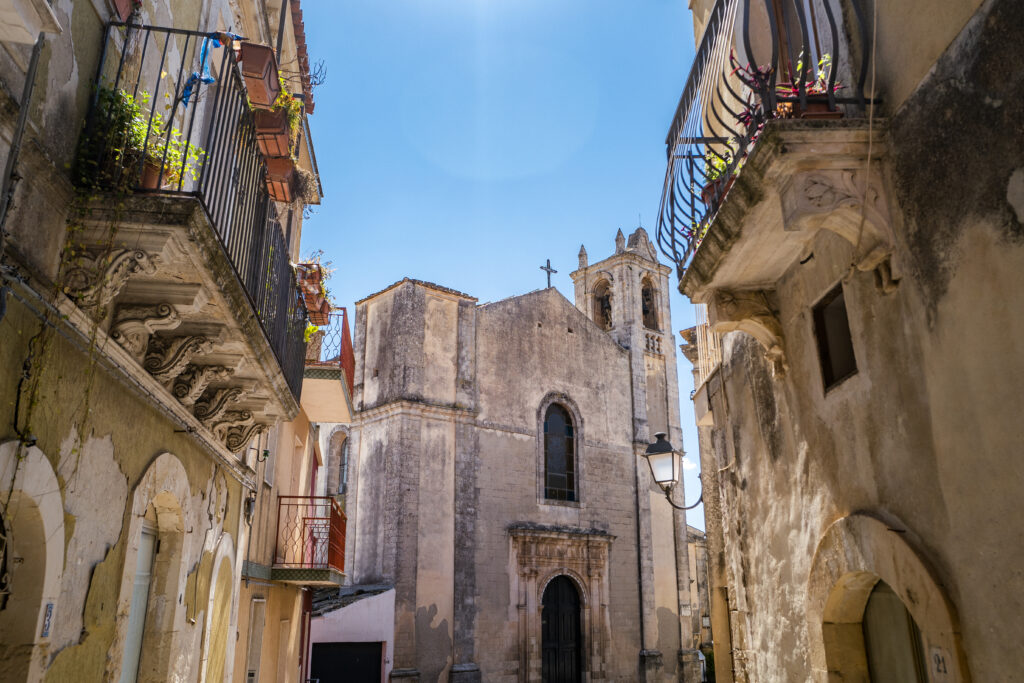
The church which was built in 1634, and after it was destroyed by the 1693 earthquake, was rebuilt in the 1700s. The facade, which is in the Romanic style, is incomplete of its second bell tower. Entering the church from the left lateral door,
the small nave, with its lateral altars, is immediately visible and the main altar of Our Lady of Sorrows is at the front with a beautiful painting by an unknown author.
This nave features three domes, two of which figure various saints and angels heads in bas-relief as well as some angels in relief that are valuable works in stucco by the Palazzolese sculptor, Sebastiano Giuliano.
In the central nave, on the left, there are the stone altars which were built in 1833 and were dedicated to Our Lady of Consolation and Saint Lucy.
The main altar, which was built in 1807 by Syracusan artisans, although austere and clear in its architectural lines, is valuable for the variety and the quality of its polychromatic marble; the basrelief of the four medaglions is well executed and represents biblical scenes which were sculpted in Syracuse. Saint Anthony’s church is devoted to Our Lady of Sorrows.
Chiesa dell' Immacolata
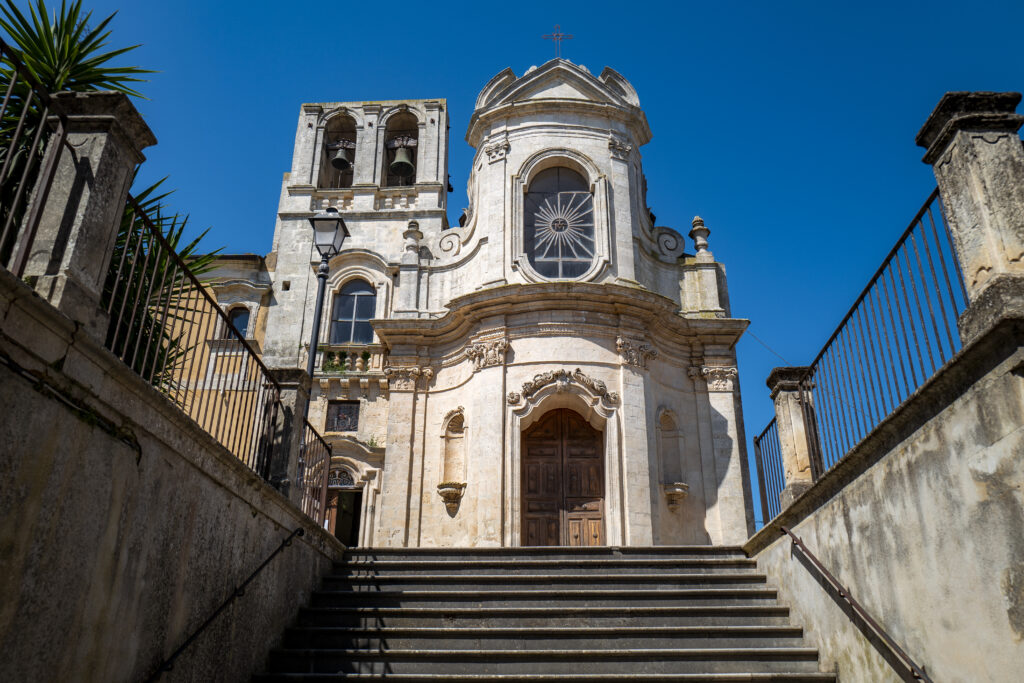
The church of the Assumption (or the Immaculate Conception), together with the Santa Maria di Gesù convent, originally situated in the highest point of the Acremonte, was destroyed by the 1693 earthquake. It was rebuilt between 1753 and 1765 at a lower site
that was closer to the inhabited centre of the town. At first it was dedicated to the Saint Anthony of Padua cult. In 1876 it was taken over by the Charitable Sisters congregation and an orphanage was established there.
In the exterior, its convex facade, the sole example in the town, is divided in two orders: in the lower order the portal has two clamshell niches, whereas the superior order has a wide window. On the left of the facade, positioned slightly further back, is the
bell tower that seems to have been built in a prior period. The interior of the church has only one nave which features lateral altars that are enhanced by stone engravings, arabesque twisted columns with broken pediments.
In the sacristy, among the more interesting artworks, the painting by Paolo Tanasi is noteworthy. Tanasi was a painter from Palazzolo and in 1818 he painted this picture which depicts Jesus Christ on the crucifix surrounded by souls from purgatory. Another particular artwork is the statue, which is sculpted from white marble from Carrara, and shows the Madonna and baby Jesus. Fancesco Laurana created it between 1471 and 1472; it is 190 cm tall and stands on a base with the inscription “Sancta Maria de la Gratia de Palazzu” and is a bas-relief of the Dominio Virginis. On one side of the base there is a shield with six balls which is the Alagona coat of arms – the town’s baron – who commissioned the work, and on the other side there is a shield with a rampant lion. Origi-
nally the statue had a painted face and a cape with a hem lined in golden stars, but in 1925 it was cleaned and lost its painted beauty, and so today it is completely white. The statue is considered the most beautiful Madonna that Laurana created.
